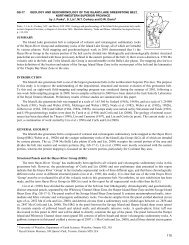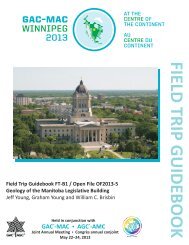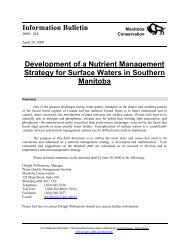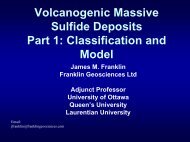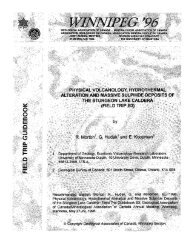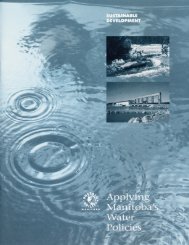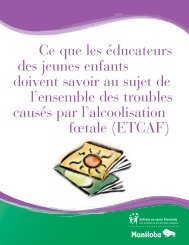Criteria for Recognit
Criteria for Recognit
Criteria for Recognit
You also want an ePaper? Increase the reach of your titles
YUMPU automatically turns print PDFs into web optimized ePapers that Google loves.
The Role of Extension and Rifting in the Formationand Location of Volcanogenic Massive Sulphide Deposits:<strong>Criteria</strong> <strong>for</strong> <strong>Recognit</strong>ionVMS Short Course“Exploration <strong>for</strong> Volcanic Massive Sulphide Deposits”Manitoba Mining and Minerals Convention November 2007Harold L. Gibson
AcknowledgementsRodney Allen, Boliden and Lulea Technical UniversityJames Franklin, Franklin Geosciences Ltd., MERC, Laurentian UniversityAlan Galley, Geological Survey of Canada, MERC, Laurentian UniversityMark Hannington, Universiy of Ottawa; MERC, Laurentian UniversitySteve Piercey, MERC, Laurentian University
OutlineExtension and Rifting - definitionExtension and Rifting - significance in VMS <strong>for</strong>mation/locationExamples from Modern Geodynamic Environments - Implications <strong>for</strong>Ancient VMS successions<strong>Recognit</strong>ion of Extension-Rifting Environments in Ancient Successions- Implications <strong>for</strong> ExplorationField (Geological) EvidenceGeochemical EvidenceFinal Remarks
Extension and RiftingRifts are fault-bounded basins produced by extension of the crust (aulacogensare failed or less active arms of rifts)Crustal attenuation andthinning of lithosphere(from Condie, 1997)Vertically extensive faultsRise of AsthenospherePartial melting ofasthenosphere andlithosphere (base of crust)- bimodal, hightemperature volcanismEpisodic dike injection,pluton/sill emplacementand volcanism alternatewith faulting and crustalsubsidence - rift+/- clasticsedimentationInitial stage of a“WilsonCycle”
Extension and Rifting(McKenzie and Bickle, 1988)(Franklin et al., 2005)•Heat: upwelling mantle causes increase in heat flux and upward warping of isotherms – the heatflux to drive volcanism and at higher crustal levels circulation of evolved seawater•Extension: provides extensive,vertical fluid conduits that are reactivated to focus dike-sillemplacement, volcanism, subsidence, and the upflow of hydrothermal fluid (e.g., synvolcanicstructures), but also provide the permeability needed <strong>for</strong> deep penetrating evolved seawater toleach metals within rifts (+/-magmatic fluid component)Thermal Corridor: High heat flow, plutonism, high-temperature volcanism, sedimentation, andsubsidence focused in time and space - essential to the <strong>for</strong>mation of high temperaturehydrothermal systems responsible <strong>for</strong> the <strong>for</strong>mation of VMS deposits
Rifting and Extension - CriticalVMS deposits <strong>for</strong>m during episodic rifting ofoceanic and continental volcanic arcs, <strong>for</strong>earcs and in back-arc extensional regimesLong lived extension - crustal thinning– rifting– high heat flow- and extensive verticalpermeability (faults) are key to developingand sustaining ore <strong>for</strong>ming VMShydrothermal systems – must be at shallowcrustal level (>10Km)Return to compressive environment results inuplift, a return to arc volcanism and potentialto <strong>for</strong>m Epithermal and or Porphyry depositsSuperposition of ore deposit types andvolcanic products….(Allen et al., 2002)
Seafloor Hydrothermal Vents and Related Mineral DepositsHannington et al., 2005, 100 th Anniv. Vol. Economic Geology
Modern Sea-Floor Hydrothermal Systems: Some Basic Facts• 300 known sites of hydrothermal activity and related mineral deposits• 100 sites of high-temperature hydrothermal activity (black smokers)• 65% on mid-ocean ridges (55,000 km)• 22% in back-arc basin environments (22,000 km including arcs)• 12% on active submarine volcanic arcs•
Examples from Modern Geodynamic Environments•intracontinental rifts• intraoceanic arcs• transitional (or island) arcs• continental margin arcs• intraoceanic back-arc basins• intracontinental back-arc basinsRifted oceanic arcs (Bimodal Mafic)and related back arc rifts (Mafic,Pelitic-mafic)
Distribution of Western Pacific Hydrothermal SystemsCentral Manus BasinPacmanus, EMBDesmos, EMBSusu Knolls, EMBManus BasinWoodlark BasinNorthern Lau BasinNorth Fiji BasinCentral Lau BasinWhite Church, VFRVai Lili, VFRHine Hina, VFRTonga-Kermadec Arcand Lau BasinBrothers Smt.Rumble IIWhakatane
Arc-frontVolcanoesBrothers VolcanoSouthern Kermadec Arc3.5 kmBrothers(de Ronde et al., 2005)Healy(40 km)Silent
(de Ronde et al., 2005)These calderas commonly host black smokers, but they are not the usual setting <strong>for</strong> large VMSdeposits. Smaller magma chambers beneath summit calderas result in smaller hydrothermalsystems and smaller, but potentially higher grade deposits. Shallower water = boiling anddevelopment of extensive stockwork mineralization. Direct magmatic contributions may besignificant in these volcanoes, leading to Cu- and Au-rich systems!White Island: Cu -110,000 kg/yr, Au – 36 kg/yr, Bi – 2190 kg/yr, S – 50,000 t/yrHedenquist et al., 1993
Early Arc Rifting and Proto-Backarc Basins• early arc rifting is characterized bynarrow depressions cutting across orlocated immediately behind the arcfront (Sumisu rift of the Izu-Bonin arc;propagating tip of the Valu Fa Ridge)• short, trough-like grabens arecommon (
15 kmMonowai Caldera (1650 m)Monowai Volcano (138 m)Monowai Caldera, Kermadec Arc
The Manus Back-arc Basins (4 m.y. old back-arc basin)Oblique collision results in hinged or radial extension in the Back-arcRifting inthickened arc crustMORBHigh-Temp
• 20 km long• 1 to 1.5 km wide• 400 to 600 m high• 1650 to 1700 mbslPual RidgeDESMOS CauldronSusuKnollsEastern Manus BasinEstimated Volume10-12 km 3
Lau Back-Arc BasinNorthFijiLauSouthFijiThe preferred setting (?) <strong>for</strong> large VMS deposits is in deeper back-arcs or near-arc rifts
km0 100anadad StateskeperiorAbitibi BeltThe interpreted setting of the majorityof Archean Cu-Zn deposits…..but consider the scale!
Lau BasinHawkins →general trendfrom N-MORBlikebasalts tomore arc-likebasalts → northto south in theEastern LauSpreadingCentreN-MORB-likeArc-likeHawkins (1995)
Examples from Modern Geodynamic Environments•intracontinental rifts• intraoceanic arcs• transitional (or island) arcs• continental margin arcs• intraoceanic back-arc basins• intracontinental back-arc basinsRifted transitional or island arcs(Bimodal-felsic) and related back arcrifts (Siliciclastic-felsic)
Distribution of Western Pacific Hydrothermal SystemsMinami EnsaiN. Iheya RidgeJADE, Izena Cauld.Yaeyama GrabenHatoma KnollYonaguni KnollOkinawaBack-arcSunrise, Myojin KnollMyojin ShoSumizu RiftSuiyo Smt.Kaikata Smt.Esmeralda18°N, Mariana T.Izu-Bonnin ArcMariana Arc13°N, Mariana Arc
Sibuet et al.,19981. Present dayand recentvolcanism2. Trench axis3. Normal faults4. Trench slopes5. Structural highsNote:• Decreasing sizeof volcanoesmoving southfrom Japan• En echelonoverlappingnormal faults innorthern OT• Depressions insouthern OT
Sibuet et al.,1998
Sibuet et al., 1998
<strong>Recognit</strong>ion of Extension-Rifting Environments inAncient SuccessionsThe recognition of extensional rift environments and high-temperaturemagmatism in ancient successions is based on :1. Geological Evidence (stratigraphic - facies)2. Petrochemial EvidenceKey to area selection during regional or district -scale exploration
<strong>Recognit</strong>ion of Extension-Rifting Environments inAncient SuccessionsGeological <strong>Criteria</strong>Ancient rift successions have definitive geological characteristicsand a predictable stratigraphy related to extension, these include:1. A pre-rift succession that could be part of an oceanic, transitional orcontinental margin arc succession, followed by a bimodal rift successiondominated either by basalts or rhyolites, and in some deposit types(Bimodal-felsic and Siliciclastic-felsic) a post-rift ,thermal subsidencesuccession dominated by deep marine sedimentary rocks2. Evidence from volcanic and sedimentary facies of rapid subsidenceand restriction of lithofacies within fault blocks e.g. megabeccias - graben,cauldron, calderas3. Synvolcanic dike swarms and/or sill complexes4. High-level, comagmatic subvolcanic pluton comprised of sill-like intrusionsof tonalite, trondhjemite and gabbro whose composition matches that ofthe associated volcanic succession5. Pervasive zones of high-temperature, semicon<strong>for</strong>mable alteration
Altay-Sayan DistrictBathurst District<strong>Recognit</strong>ion of Extension-Rifting Environments inVolcanic StratigraphySiliciclastic-felsic DepositsFranklin et al., 2005Franklin et al., 2005
<strong>Recognit</strong>ion of Subsidence in Ancient Successions
Dikes in FlowsDikes in volcaniclastic rocks<strong>Recognit</strong>ion of Extension=extensive, synvolcanicdike swarms
Icelandite DikePeperiteBasalt DikesMassive andFlow bandedFP Basalt Dike
1 st Generation2 nd Generation
Basalt Pillow VolcanoBeddedTuff, LapilliTuffBasalt DikeBasalt SillsFP GabbroDikeFp, PyxBasaltGabbroSill
Basalt DikePillowFB BasaltDike
“Megabreccias”Evidence <strong>for</strong> Extension and Subsidence• Megabreccia – is a breccia, typically heterolithologicand comprised of clasts that range in size from lapilli,to large metre-sized to kilometre-sized blocks. Thebreccia is massive, poorly sorted, but can be crudelylayered.• Forms during initial caldera collapse and includelithologies exposed on the caldera walls/margins, aswell as juvenile components.
PillowedBlockMega-Breccia – Evidence <strong>for</strong> Subsidence
Dike SwarmCore of Subsidence StructureDown-dropped to NorthIntense Epidote-Quartz alteration
<strong>Recognit</strong>ion of High-Temperature Semicon<strong>for</strong>mable,Hydrothermal AlterationSilicified AndesiteEpidote-Quartz Basalt
<strong>Recognit</strong>ion of Subvolcanic PlutonsMultiphase, sill-like subvolcanic intrusions/plutons represent theintrusive equivalent of the magma chambers(s) that accommodatedsubsidence and resurgent post-subsidence magmatism.
.Subvolcanic Plutons
Seafloor Manifestation of Rifts: Constructional Edifices
Caldera <strong>Recognit</strong>ion• Multiphase, sill-like, subvolcanic intrusion• Abrupt change in the thickness and orientation of units• Extensive, thick, pyroclastic/volcaniclastic deposits• Thick, ponded flow succession - low aspect ratio• Internal angular and erosional uncon<strong>for</strong>mities• Megabreccias - A product of collapse• Numerous dikes and sills – dike swarms (cone sheets)• Synvolcanic Faults – orthogonal, radial or concentric• Intense semicon<strong>for</strong>mable alteration
VMS deposits are located within and adjacent to caldera where they occur withinvolcanic vents localized along synvolcanic faults and fissuresLike VMS deposits caldera <strong>for</strong>mation occurs late in the evolution of volcanoesCaldera <strong>for</strong>mation is associated with high heat flow and cross-stratal structuralPermeability that is focused in time (explains the time-stratigraphic control) andspace (explains the clustering of deposits).Shallow magmatism offers potential <strong>for</strong> a magmatic hydrothermal contribution ofmetalsPreservation
<strong>Recognit</strong>ion of Extension-Rifting Environments inAncient SuccessionsPetrochemical <strong>Criteria</strong>:Ancient rift successions have a chemostratigraphy defined bydistinct petrochemical assemblages of mafic and felsic rocks that areindicative of an extension that differ somewhat with geodynamicsetting and, there<strong>for</strong>e, with Lithostratigraphic Deposit TypeA VMS productive rift succession should contain high-temperaturefelsic (e.g., FIII-FII, HFSE-enriched) and mafic (e.g., BON-LOTI,MORB) volcanic (intrusive) rocks
Lithostratigraphic Classification of VMS DepositsType Typical Facies Petrochemical Assemblages Tectonic Setting(Inferred <strong>for</strong> Archeanexamples)MaficDominantly mafic flows and, 10% felsicflows/domes. Mafic sills and dikescommon, minor argillite and chert.(Ophiolitic assemblages)MORB- LOTI-boninite basaltsMature intra-oceanicbackarcsExamplesSouth Urals, RussiaCentral Newfoundland, CanadaTroodos, CyprusSemail, OmanPontides, Turkey and AlbaniaPelitic-maficMafic sills, subordinate flows withargillite, carbonaceous argillite subequalor dominant, minor chert and trace toabsent felsic volcanic facies.MORB, EMORB basalts,Alkaline basalt (OIB)Sedimented mid-oceanridges, trans<strong>for</strong>ms orbackarcsOutokumpu, FinlandLabrador Trough, Windy Craggy, CanadaMid and South Urals, RussiaBesshi district, JapanBimodal-mafic Dominantly mafic flows with up to 25%felsic flows/domes and subordinatefelsic/mafic volcaniclastic rocks andterrigenous sedimentary rocks (wackes,argillites)Bimodal-felsic Felsic flows/domes, volcaniclastic rocksdominant with 10-40% mafic flows andsills and /= FII rhyolitesMORB, OIB-Alkalic basaltFII (
VMS- and Rift-Related Mafic Rocks• In mafic dominated settings (Mafic, Pelitic-Mafic, Bimodal-mafic):– Boninites and depleted island arc tholeiites (IAT)– MORB and back-arc basin basalts (BABB)• In felsic and sediment-dominant (Bimodal-felsic, Silclastic-felsic)– settings important to find alkalic and MORB.• Transitions from arc to non-arc signature mafic and felsic rocks areevidence <strong>for</strong> rifting and most VMS deposits occur within suchtransitionsArc to rift transitions in stratigraphy!
Boninites (LOTI), Depleted ArcTholeiites and VMS• Basaltic andesites with high MgO (>10%), Ni, Cr.• Very low HFSE and REE content• Depleted (U-shaped) normalized REE patterns.• Often associated with depleted tholeiitic• Require high temperatures to melt - indicative of highheat flow environment - necessary to drive hightemperatureVMS hydrothermal systems.• Examples: Kidd Creek, Snow Lake, Rambler-Ming,Fyre Lake
Piercey and Gibson, 2005
Piercey and Gibson, 2005
Piercey and Gibson, 2005
Rock/Chondrites REEs-Nakamura 19741000100R10EAPAMORBILOTIKOM11000La Ce Pr Nd Pm Sm Eu Gd Tb Dy Ho Er Tm Yb LuRock/Primitive MantleSun/McDon. 1989-PM100101(Bleeker et al., 1999)(Wyman et al., 1999).1Cs Rb Ba Th U Nb K La Ce Pb Pr Sr P Nd Zr Sm Eu Ti Dy Y Yb LuComplex Rift to Arc Transition - Plume Interaction
VMS- and Rift-Related FelsicRocks• In Felsic dominated successions (Bimodal-felsic, SiliciclasticFelsic):– HFSE- and REE-enriched rhyolites in felsic dominatedenvironments– FII - FIII Rhyolites• In Mafic dominated successions (Mafic, Pelitic-Mafic, Bimodalmafic):– often primitive “tholeiitic” rhyolites (these often associatedwith boninites and primitive arc tholeiites, or MORB)– FII - FIII-FIV Rhyolites
Kidd CreekBathurstEskay CreekFinlayson LakeNb1000100Syncollisional(S-type)Fields after Pearce et al. (1984)within-plate(A-type)within-plate &anomalous ocean ridge10volcanic arc(I-type)ocean ridge(OR-type)M-typeData Sources:Kidd: Prior et al. (1999), Schandl et al.(1999)Bathurst: Whalen et al. (1998), Lentz(1996, 1999), Rogers et al. (2003)Eskay Creek: Barrett and Sherlock (1996)Finlayson Lake: Piercey et al. (2001, inreview)11 10 100 1000YHFSE- and REE-enrichedfelsic rocksPiercey and Gibson, 2005
FI-FIV RhyolitesAfter Hart et al., 2004
Generation of FI- FIV RhyolitesFI FII FIII-IVAfter Hart et al., 2004
after Piercey and Gibson, 2005
after Piercey and Gibson, 2005
VMS- and Rift-Related FelsicRocks: The Exceptions• Primitive arc terranes have rhyolites that are oftenHFSE and REE depleted - FIV Rhyolites• Rhyolites are typically depleted in trace elements.• They are spatially associated, however, with hightemperature mafic magmatism: boninites, depleted arctholeiites, and MORB.• Are high temperature melts, but low HFSE-REE due tolow contents in the source regions <strong>for</strong> the rhyolites.• Examples: Flin Flon, Snow Lake primitive arcsequence, Rambler-Ming
Fields fromPearce et al. (1984)Piercey and Gibson, 2005
Piercey and Gibson, 2005
Final RemarkThe most valuable “exploration tool” is a motivated andknowledgeable geologist!“Despite the promise and success of variousgeochemical, geophysical and GIS methods theseshould be considered ancillary to acquiring thegeological context, and ensuring that staff can relate thecharacteristics defined by the VMS model to empiricalobservations made on the ground”Gibson et al., 2007



